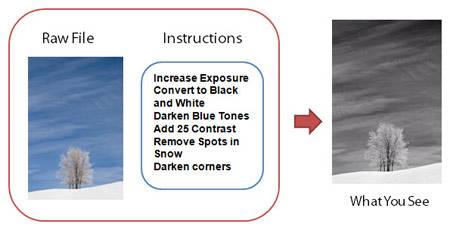 This is my first article in what will be a several part series on Lightroom’s Export function. This article will focus on what exporting is for and when you should export. Future ones will go into the settings.
This is my first article in what will be a several part series on Lightroom’s Export function. This article will focus on what exporting is for and when you should export. Future ones will go into the settings.
Background: Lightroom’s Non-Destructive Approach to Image Editing
Lightroom works non-destructively, meaning that it never touches your original raw or JPEG files. Instead, your editing work is saved separately behind the scenes as a set of instructions. In Lightroom you’re essentially seeing the instructions hovering over your original photos, but the instructions are not baked in to your originals. This is great, as it means that you can undo all or part of your work at any time – you can’t ruin your photo as you work on it!

What Exporting Is For
Because of this non-destructive approach, if you go outside of Lightroom to Mac Finder or Windows Explorer/My Computer and preview files that you have edited, you’ll see that your editing work isn’t there – so you can’t share your edited photos with people by sending them these files. Of course sending people the originals plus sets of Lightroom instructions also isn’t an option. Instead, when you want to share your photos you’ll create copies of them with the editing work applied. These copies are made through the Export dialog.
Should I Export to Save My Work?
Many users believe they need to export copies of all their edited photos in order to save their work – this is not the case, and will simply clutter up your hard drive with unnecessary copies. Your work is being saved automatically in Lightroom’s catalog. (Read more about this in, “How Do I Save My Lightroom Work?“) Instead, exporting copies is only necessary when you want to share your photos with the outside world.
Should I Keep All My Exported Copies?
I almost always delete the exported copies once I send them out since I can always export new copies if I need them again. Each export shows up as an entry in the History panel in the Develop module, so if I have done additional editing since I exported, I can always get back to how it looked when I last exported, if I need to. Some pros, however, do retain the copies that they send to clients so that they have readily-accessible documentation of exactly what was sent out. (Note that while Lightroom will record editing settings when you perform an export, it will not record export settings such as size, so if you need to keep track of these you’ll need to keep your files.)
Whether or Note You’ll Need to Use Lightroom’s Export Dialog
Generally speaking, you’ll export copies by clicking on the Export button in the bottom right in the Library Module, or by going to File>Export…, and then working through the settings.
![]()
However, there are other ways to share photos, depending on the circumstance. In these Lightroom does the under-the-cover exporting:
- You can email photos directly from Lightroom. This will save you from the time of exporting JPEGs and attaching them to emails.
- You can upload photos directly to Facebook, Flickr and some other online services using Publish Services, in the bottom left in the Library module.
- Creative Cloud subscribers can “sync” collections of photos to the cloud, at which time they are available on mobile devices and on Lightroom web. You can send clients and friends links to these collections on the web and people can like and comment on them.
- You can create slideshows, web galleries, prints and electronic print layouts, and photo books using Lightroom’s output modules, and then export / upload / print from there.
These are outside the scope of my current Export series, but I thought I’d mention them.
Related Post: Exporting Lightroom: Location Settings
